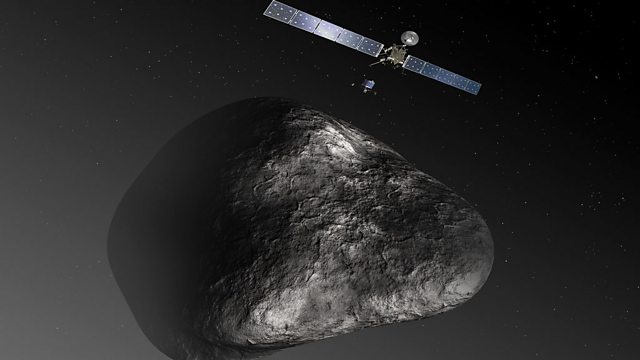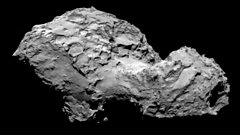Rosetta Mission Arriving At Comet
Looking ahead to the European Space Agency’s Rosetta mission – the first spacecraft to follow a comet and land a probe on its icy surface. What will it find? Will it all work?
On 6th August, the space probe Rosetta ends its 10 year journey and arrives at Comet 67P/Churyumov-Gerasimenko. If all goes well, Rosetta will be the first spacecraft to go into orbit around a comet. The European Space Agency probe will then accompany the comet until December 2015, studying the 4 kilometre-wide lump of ice and rock dust at a level of detail far surpassing any previous comet flyby.
In the words of Rosetta scientist Joel Parker, “Previous comet missions have been one-night stands, Rosetta will be there for a long term relationship.”
Rosetta will stay with 67P as it heads towards and around the other side of the Sun. Rosetta will be watching everything at close quarters as the comet heats up and produces the classic gas and dust comet tail.
In the final weeks of approach, the Rosetta team have realised this is going to be an even more interesting mission than they had supposed. In the middle of July, the probe’s camera revealed the bizzare shape of the comet’s nucleus. It appears to be formed of two objects joined together. Some have described it as having the shape of a toy duck.
In November, Rosetta will send a small robot lander, Philae, down onto the comet’s surface – another hugely ambitious feat, given the feeble gravitational pull of the comet and its complex shape. Philae could bounce off into the void if its trajectory is not quite true and its on-board harpoons fail to secure it to the comet’s icy surface.
Discovery looks ahead to the mission’s key moments and big science questions with planetary scientists and members of the Rosetta science team:
Professor Ian Wright - principal investigator (PI) for the lander’s Ptolemy instrument,
Professor Monica Grady - planetary scientist at the Open University, UK.
Matt Taylor, project scientist on Rosetta
Dr Joel Parker - deputy PI for Rosetta’s Alice spectrometer
Dr Holger Sierks - principal investigator for Rosetta’s Osiris camera
Dr Stephan Ulamec - project scientist for the lander Philae (German Space Agency)
The big questions for Rosetta include: did comets bring water and the essential ingredients for life to the early Earth?
Presented and produced by Andrew Luck-Baker
Image Credit: Rosetta and Philae at Comet, European Space Agency
Last on
Comet viewed from Rosetta at 300 kilometres

Comet viewed from Rosetta at 300 kilometres
Credit: ESA/Rosetta/MPS for OSIRIS Team MPS/UPD/LAM/IAA/SSO/INTA/UPM/DASP/IDA��
��
Broadcasts
- Mon 4 Aug 2014 18:32GMT���˿��� World Service Online
- Tue 5 Aug 2014 01:32GMT���˿��� World Service Online
- Tue 5 Aug 2014 08:32GMT���˿��� World Service Online
- Sun 10 Aug 2014 23:32GMT���˿��� World Service Online
Space
The eclipses, spacecraft and astronauts changing our view of the Universe
The Curious Cases of Rutherford and Fry
Podcast
-
![]()
Discovery
Explorations in the world of science.




